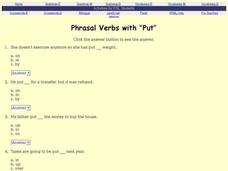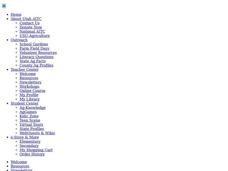Curated OER
Phrasal Verbs with "Put"
For this phrasal verb/put worksheet, students complete a total of 10 multiple choice questions, selecting from a choice of 3. Students may click on an "answer" button for immediate feedback. Worksheet is labeled as an ESL activity, but...
Curated OER
Homonyms Quiz
In this homonym worksheet, students complete 20 multiple choice questions, choosing the correct word to complete sentences. Worksheet is labeled ESL, but is not exclusive.
Curated OER
Consumer Power
Students examine the labels on their own clothes to determine where they were made and think about important factors when shopping for different items. They figure how much the person who makes their sneakers would get and complete a...
Curated OER
The Seasons
Students label posters with the four seasons of the year. They draw or use magazine pictures that demonstrate the clothing worn for each season. They brainstorm a list of holidays that occur within each season.
King Country
Lesson 2: Private & Public
What is the difference between a private and a public place? The focus in this second instructional activity on family life and sexual health is building an understanding of the difference between the concepts of private and...
Curated OER
What Can We Learn From the Past?
What would future archeologists learn from your scholars' personal belongings? Have them bring in a box of "primary sources" from their home. Discuss the difference between observations and inference, using some of your own items to...
Curated OER
Understanding the Body: Day 2, Puberty
Everyone needs to know what to expect when going through puberty. Intended for a special education class, this well developed and developmentaly appropriate resource provides a full days instruction on teaching teens with special needs...
Curated OER
What's on My Plate?
Kids work together in groups to discuss and understand the differences between a typical diet and a healthy one. They use the My Plate recommendations to compare what they eat with what they should be eating according to the MyPlate...
Curated OER
Reproduction, Day 2: Pregnancy
Nearly all students have seen pregnant women and may have questions about human development. Intended for secondary students with mild to moderate mental disabilities, this lesson defines the process of pregnancy in a...
Curated OER
Understanding the Body, Day 3: Sexual Health & Hygiene
Ideal for secondary moderately disabled special ed students, this instructional activity focuses on personal hygiene and self-care. They discuss a case study and role-play to introduce the importance of good hygiene then discuss current...
Curated OER
Sand Explorations
Young scholars experiment with different samples of sand from Maui leeward and windward beaches. They create a sand map to suggest at least one contributing factor for the formation of each beach sample. They test the samples to...
Curated OER
Physical Science: Festival of Bubbles
Investigate bubbles through the use of scientific inquiry. Pupils blow bubbles using several methods and measure the resulting bubble print. Measurements are recorded on a data table and transferred to a bar graph. Results are discussed...
Dick Blick Art Materials
“Gawu” — African-influenced Tapestry
Here's a great way to combine environmental science with art. Kids use recycled materials to create their own Gawu, a tapestry made of discards. Although designed for special education classrooms, the activity is sure to engage all...
Curated OER
Radio Program
Students identify and assess the impact of unions on workers, management, and community. They listen to radio stories, students are asked what can they conclude about the impact of unions on the lives of the workers, management, and...
Curated OER
Human Cheek Cell
Get up close and personal with human cells with this lab instructional activity. Learners use a microscope to examine their own cheek cells, drawing diagrams of the cells and identifying the parts when they have focused in on a visible...
Curated OER
Our Natural Resources
Your class will learn about natural resources and man-made items and differentiate between them. They chart resources from seven pictures and explain how each natural resource is used.
Curated OER
Pre-AP Strategies for French Language and Culture
Build vocabulary, fluency and confidence in your French speakers by having them participate in some of these engaging activities. Several suggestions are given, but you will have to design the actual lesson yourself.
Curated OER
Getting the Most Nutrition from Your Food
Healthy eating is a habit that one can never start too early. Learners in grades five through seven, work through a series of activities and informational reading to understand how to make good food choices. You'll find a full...
Curated OER
Jay-Z: Famous People, ELL Assignment
This lengthy assignment was designed for English language learners. It includes a 1-page reading on the rapper, Jay-Z, and 10 activities/exercises that focus on listening and reading comprehension, speaking, vocabulary acquisition,...
Curated OER
Understanding the Body, Day 2: Puberty
What is puberty? Get your secondary special needs students on the right track with this develpmentally appropriate lesson. They define and describe the differences between men, women, boys, and girls, discuss major events that mark...
Curated OER
Tobacco: Promotion Tactics and the Law
Youths aged 13 & 14 are most likely to notice and remember in-store tobacco promotions. Class members dissect tobacco advertising tactics and learn about relevant legislation by participating in guided discussion. Assessing...
North Clackamas School District
Context Clues: Synonyms
What do you do when you find a word that's not familiar to you? Help readers use context clues when encountering unfamiliar words with a grammar activity. They note the parts of the sentences that show the meaning of the word,...
Safe Drinking Water Foundation
To Filter or Not to Filter
Drinking clean water can be taken for granted. Explore the process and high cost of filtering water with a water pollution and filtration activity. Young scientist build a filtration system to filter polluted water, examine the economics...
Mathed Up!
Pie Charts
Representing data is as easy as pie. Class members construct pie charts given a frequency table. Individuals then determine the size of the angles needed for each sector and interpret the size of sectors within the context of frequency....

























